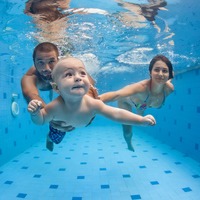
Parents would never put their children at risk on purpose. But there are some things that parents may unknowingly do that could increase the chance that their child could drown.
It may be far too early for the neighborhood pool to open – or
for you to open up your own pool – or time for a vacation to a destination in close proximity to water. But ‘early’ is the perfect time for improving your knowledge of how to ensure your children are protected from as many risks to their well-being as possible.
Drowning is the leading cause of accidental death among children ages 1 to 4 years old, according to the CDC, the Center for Disease Control. In 2015 only during the time period between Memorial Day and Labor Day, 209 children drowned in swimming pools and another 76 in lakes, notes the USSSA, the United States Swim School Association.
Teaching children to swim can save lives. It is a proven fact.
But as parents, we each have our own preference or belief in what the age is that children should learn to swim.
Here are some actions that you may not be aware can pose a risk to your child’s well-being:
Don’t act nonchalant about getting in the water.
It’s important to have a process your child must go through before entering a pool. For example, putting on a swim diaper, changing into a swimsuit and applying sunscreen. The importance of the process also stresses the importance of not simply jumping into the pool at any time. This can help reduce the potential temptation for your child to go swimming without you being aware of it.
Don’t let your child be the one to decide when they can get into the pool.
Have a verbal cue that your child must hear from you before jumping in the water. This will create an additional barrier of entry for your child and will teach your child that jumping into the pool requires permission.
Don’t use flotation devices or water wings.
Life jackets are designed to save a child from drowning when they are in open bodies of water like lakes or the ocean. They are not meant to give the child a sense of security in a pool. Flotation devices and wings can slip off and be out of reach of the child.
These items give the child the sense that he is safe in the water, when he actually is not. Instead, teach your child to locate, swim to, and then climb hand-over-hand along the pool wall to a step or ladder where a safe exit can be made from the pool if they feel uncomfortable or tired in the water.
Don’t always use goggles with your children in the pool.
Teach your children how to open their eyes under the water without goggles so that they can look for the way to safety if they fall in the water.
Don’t let your fears keep them from learning to swim.
As a parent participating in swim lessons or even teaching your child to swim yourself, don’t transfer your fear to them. If you see your child’s face dip below the surface of the pool, don’t panic. This will only make them afraid of the water or swimming or both. Help your child practice activities like blowing bubbles and putting their face under water in the bath tub so that you and your child both get comfortable with it.
The best way to make your children safe is to make sure they learn to swim. If your child cannot swim, we have a few to-dos for you:
- Remember that your child will react to your reaction. Remaining calm and positive is the best attitude that you can emit when you’re in the water with them.
- Make sure your children are always under adult supervision around the water.
- There is always a fence and barriers around pools.
- Know or learn CPR.
- Enroll your children in swimming lessons so they can be as safe as possible around any body of water and everyone can jump in and have fun swimming and playing in the water.
Little Otter Swim School’s team members are passionate about teaching kids to swim and be safe as they enjoy the water. Learn more about what makes Little Otter different.


Conversations